This post may contain affiliate links. Please read our disclosure policy.
How to make powdered milk at home from fresh milk – using just a large saucepan and fresh milk.
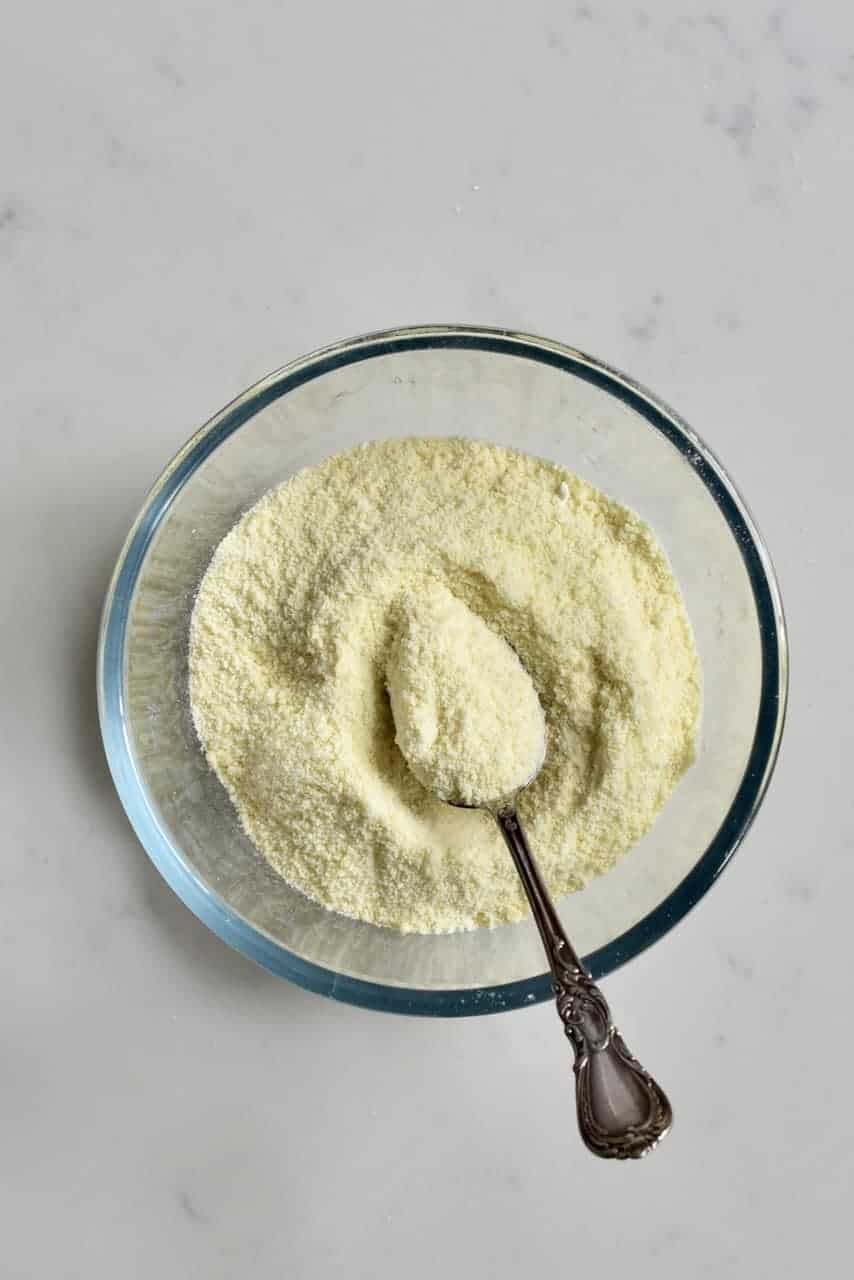
Making homemade powdered milk is not only a simple process, but it can also extend the life of milk nearing its use-by date by months (if not years), as well as keep your dairy supply going for longer. So if you find yourself in the situation where you have lots of milk and no way to possibly use it before it sours, then making milk powder can be a great way to reduce waste and prolong your dairy.
I recently did this DIY for homemade Coconut Condensed Milk and was curious about what would happen if I just continued to leave milk on the heat after it’s reached ‘condensed’ levels – the answer is a thick milk paste that can be turned into milk powder.
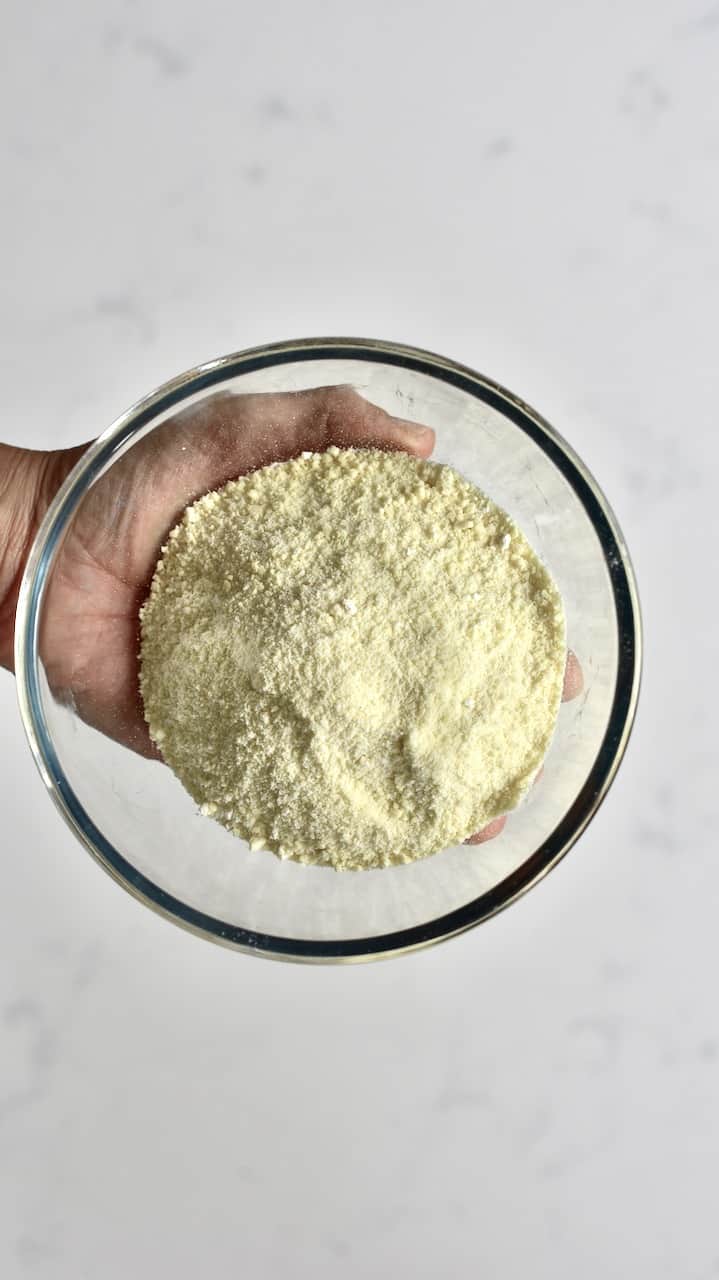
I don’t drink a lot of dairy milk, however, for the times that I do – I will sometimes struggle to finish the entire bottle of store-bought milk within the short shelf-life. By making your own powdered milk, you can reduce waste, use the milk at a later date and keep it on hand for emergencies in long-term storage.
Now, I know that in the interest of being completely honest, milk powder doesn’t taste as good as fresh regular milk. I don’t think many people expect it to be, to be honest. However, there are some tips to also combat that worry too, which I’ve included below!
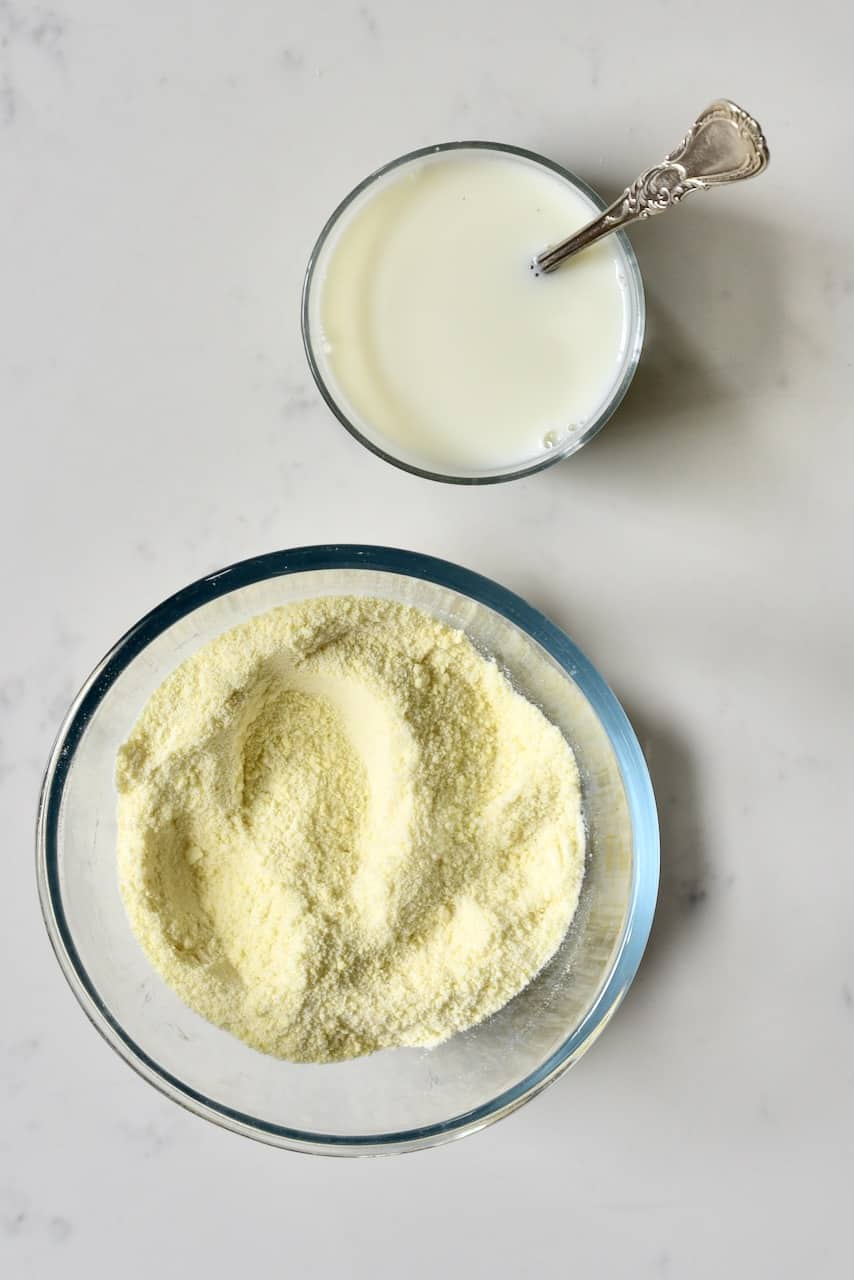
Want to save this recipe?
What is milk powder?
Perhaps not surprisingly, powdered milk is exactly what it sounds like. Milk that has been turned into a dried milk powder through an evaporation process. This is done by removing all of the liquid from the milk until just solids remain – which can be made into a powder.
There are multiple types of milk power products you can get – including whole milk (full fat) and skimmed. You can also get a number of other powdered dairy products such as whey and buttermilk.
As I’ve said above, this is done to preserve it and reduce bulk. Plus, milk powder doesn’t even need to be refrigerated.
Plus, perhaps the most interesting thing that I have found out – making homemade milk powder doesn’t deplete the health benefits of the milk. Through the slow process of heating, the minerals and vitamins remain intact. In fact, the only thing you do lose is water content and extra moisture.
Plus, this natural product requires no additional preservatives, so can be kept chemical-free.
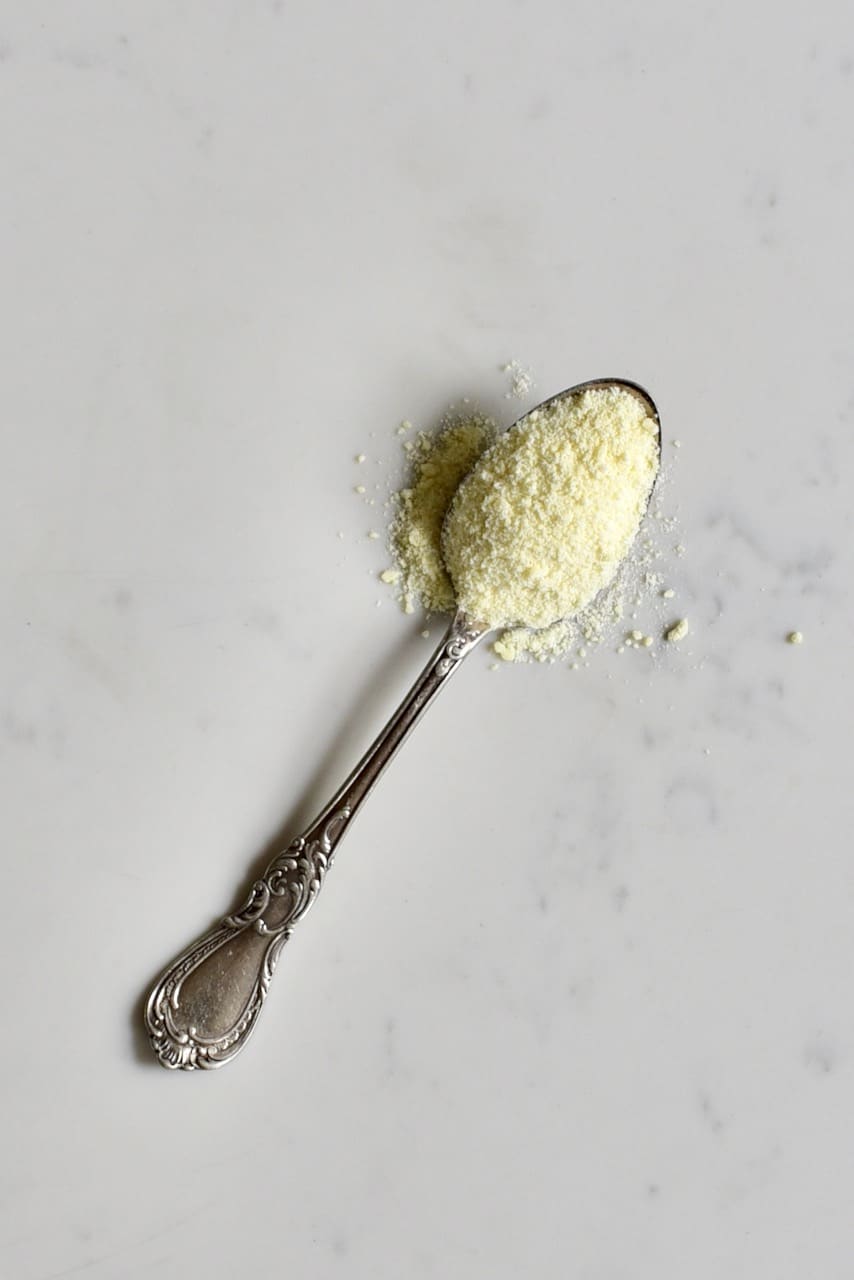
A few Notes on making homemade powdered milk
- While any milk can be used for drying (skim milk, full fat, etc.), it should always be a pasteurized milk, due to the reduced bacteria content. So I wouldn’t suggest using raw milk.
- Skimmed milk will generally have a longer shelf life, due to the lower fat content.
- There are multiple methods for making milk powder at home. The two easiest methods include using a dehydrator and the method I use below. I’ll include a note in the recipe card below about the dehydrator method.
- The key to this DIY is making sure all of the moisture is completely removed – to stop mould from being able to grow (as it needs moisture). On top of that, make sure the container you store it in is also completely dry and airtight. Some people actually vacuum seal it, to further extend the shelf life.
How to Reconstitute the Milk Powder
Since this is a DIY I previously didn’t know too much about, I’m no expert in the art of reconstituting milk powder. With that in mind, I decided to turn to supermarket versions, to see what they suggest.
And that is where confusion sets it. In the end, after LOTS of research, I discovered three main methods:
– 1:2 ratio of milk powder to cold water
– 3 tBsp of milk powder to one cup of water
– and 1 tBsp of powdered milk per one cup of water
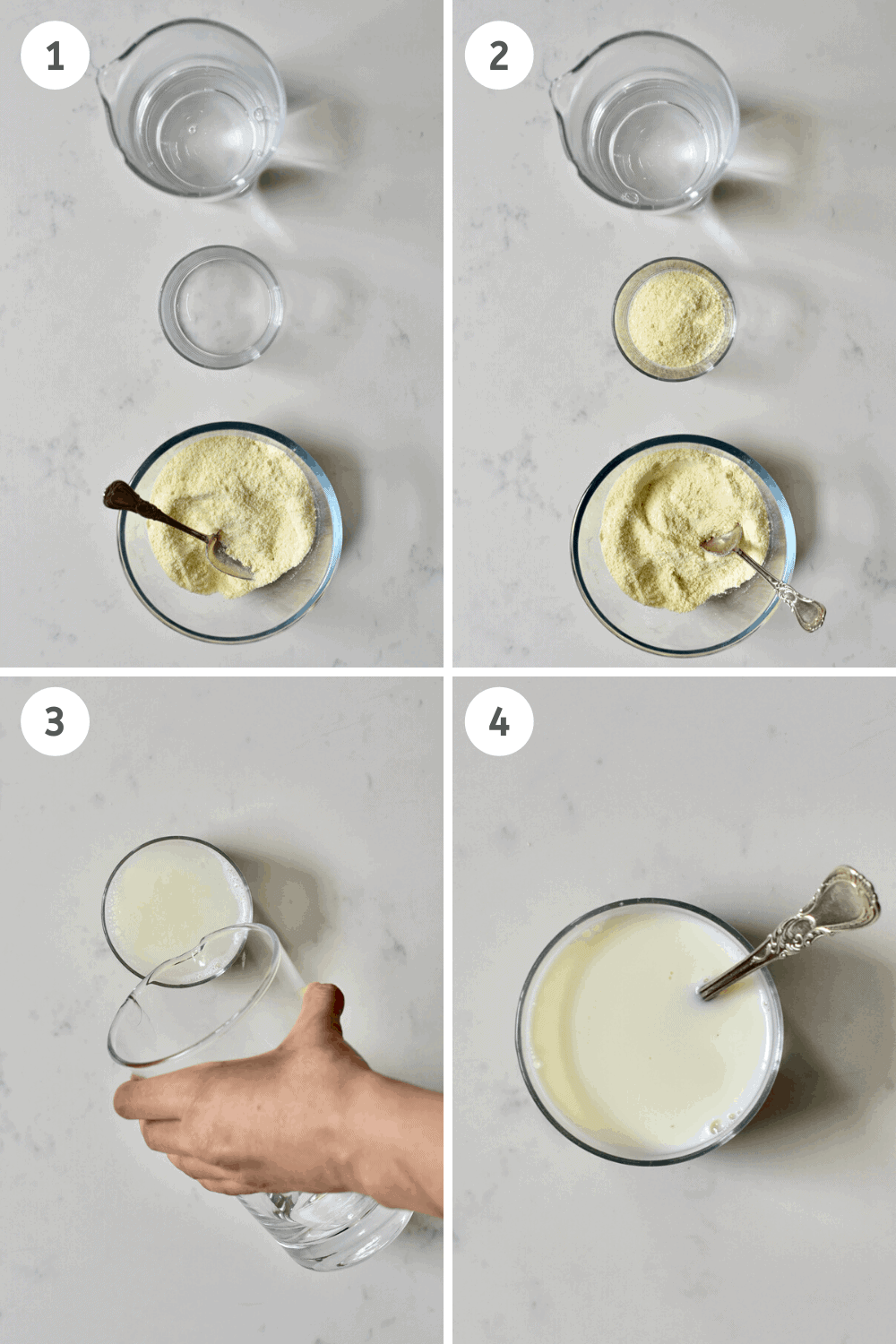
With the whole idea of this DIY being to make a product last longer, I decided to go with 1 tBsp of powder per glass of water and then increase the amount if needed, but I found that I didn’t have to. I’d say that you should do the same – start with 1 tBsp and increase, if needed.
I have learned a few tips on making the most of your reconstituted milk too. For example:
- You can add a little bit of homemade vanilla extract into the milk – it’s delicious! Although obviously best for if you’re dedicating that ‘batch’ to sweet purposes.
- For a super ‘cheat’ at making your milk taste better, you can actually mix it in with a 1:1 ratio with milk you already have in your fridge. If the milk from the fridge was full fat then your resulting mixture will be equivalent to 2%. However, this helps your milk go further while also keeping it tasting creamy and rich.
How to make milk powder
Homemade Powdered Milk is very easy to make. In fact, there are a few different methods to make the milk powder including on a hob, in a dehydrator tray, and my preferred method – in the oven.
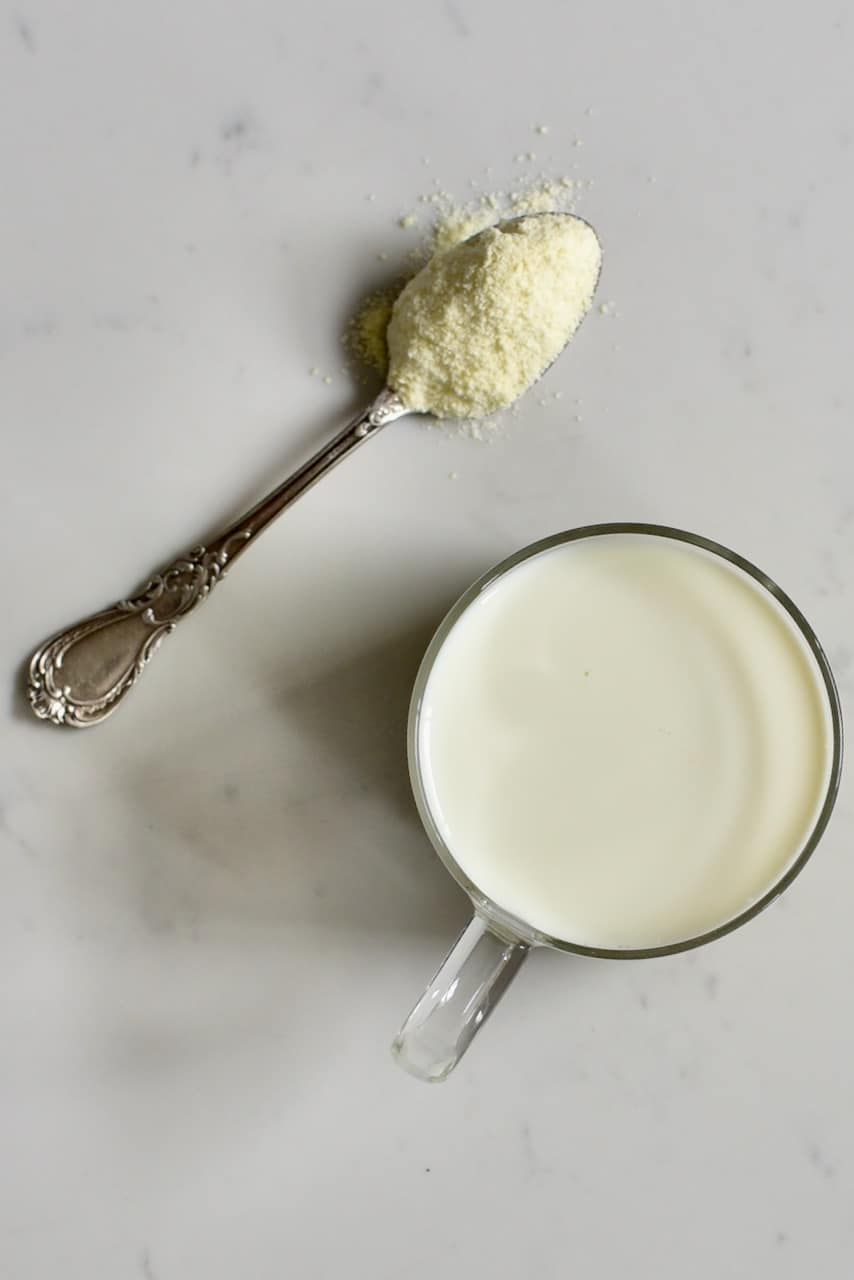
Needed
1 liter full-fat fresh milk yields about 150g of powdered milk.
You’ll also need a variety of oven-safe dishes. The larger the surface area then the faster the water will evaporate from the milk
Steps
Pour room temperature milk into a big oven-safe dish. It’s best to keep the milk at shallow levels, to dry out quickly. I tend to keep it at a maximum of an inch.
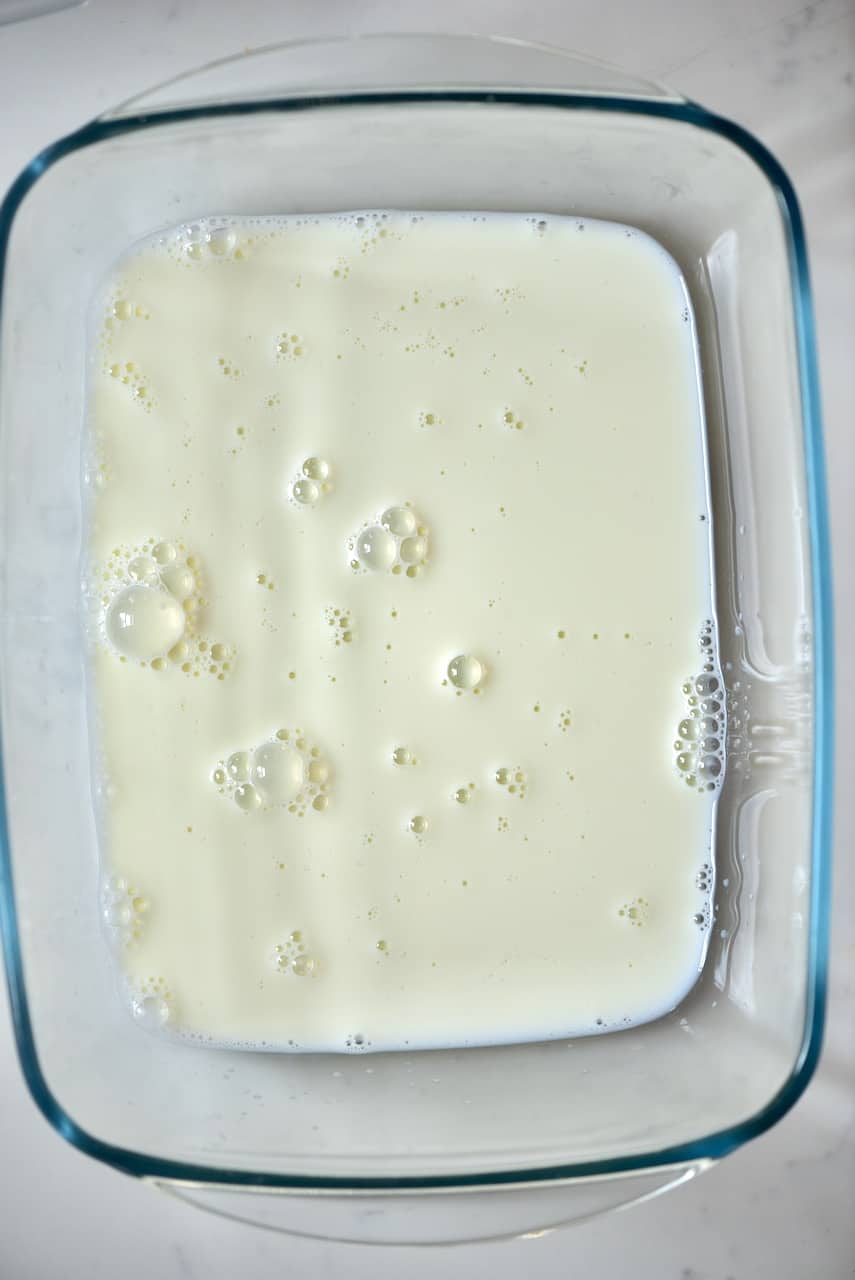
Depending on the size of your oven and/or dish, you can pour the milk into several dishes.
Note* If you want to use a dehydrator then you follow a similar method, pouring milk onto the dehydrator trays (or place a large dish in the dehydrator) and dehydrate at very low temperature over a long period of time. I found good results at 57ºC for around 8 hours, stirring occasionally. However, it can take up to 12 hours depending on how much milk you pour on each tray.
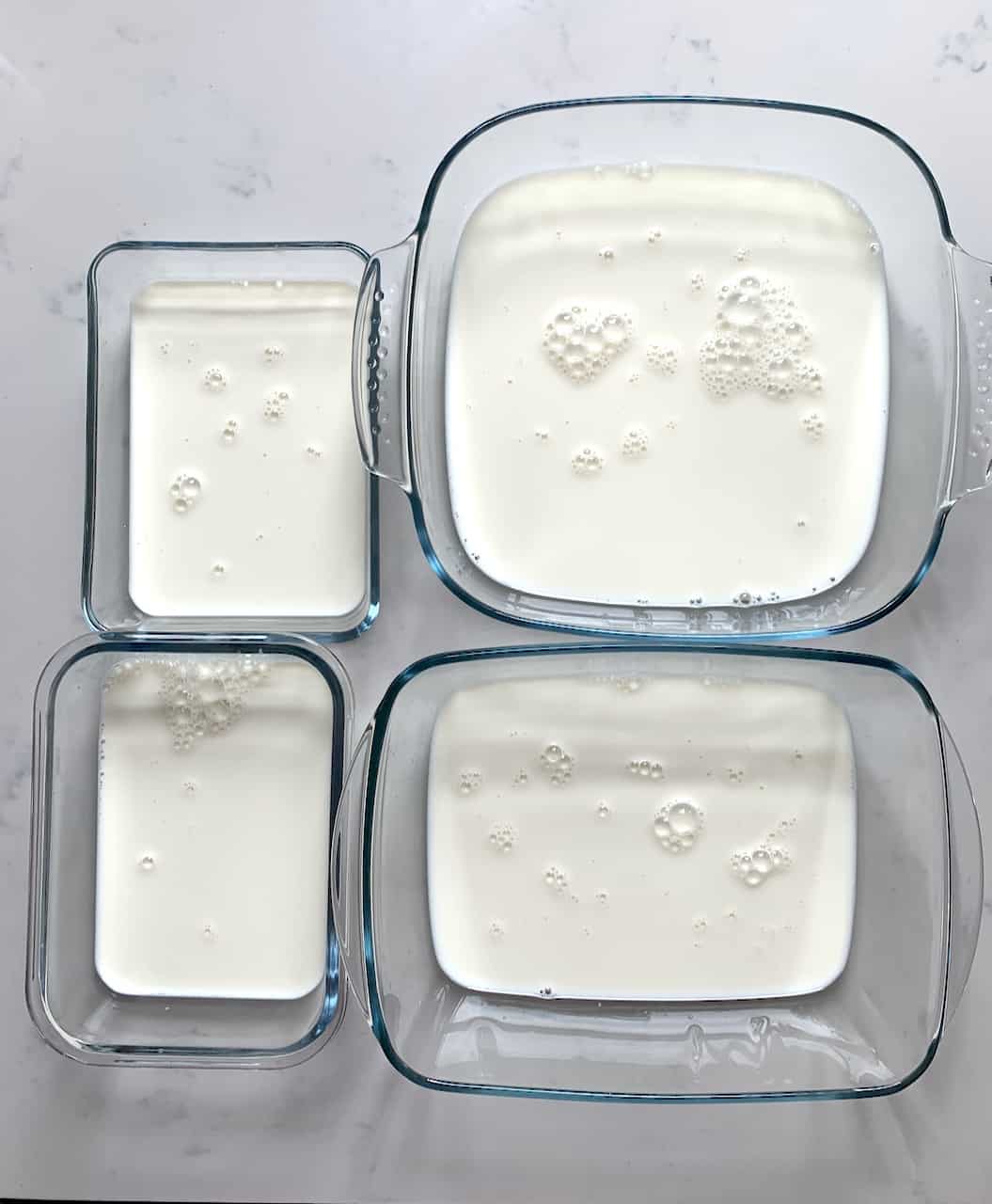
Next, place the dishes into your oven at its lowest temperature. If it can go as low as 50-60ºC, then that’s ideal. Otherwise, select the lowest temperature that you can, using the fan-assisted option.
If you don’t have a fan option then leave the oven cracked open slightly, to let the evaporating liquid out so the milk dries quicker.
As the water evaporates, the milk will become pastier and pastier until finally, it becomes a thick paste. Make sure the milk paste doesn’t turn brown while drying – that’s a sign that the temperature is too high.
Stir from time to time – this allows the water to evaporate evenly, especially when the milk starts turning to a paste.
Note: If you stop in the middle of the process, you get condensed milk.
Once you get the milk paste, spread it out on a tray or over parchment paper and return to the oven or dehydrator to finish drying the milk.
Once the paste is completely dry, you will be able to easily remove it from the tray/baking sheet. At this point, it will be easily swappable, with no bend.
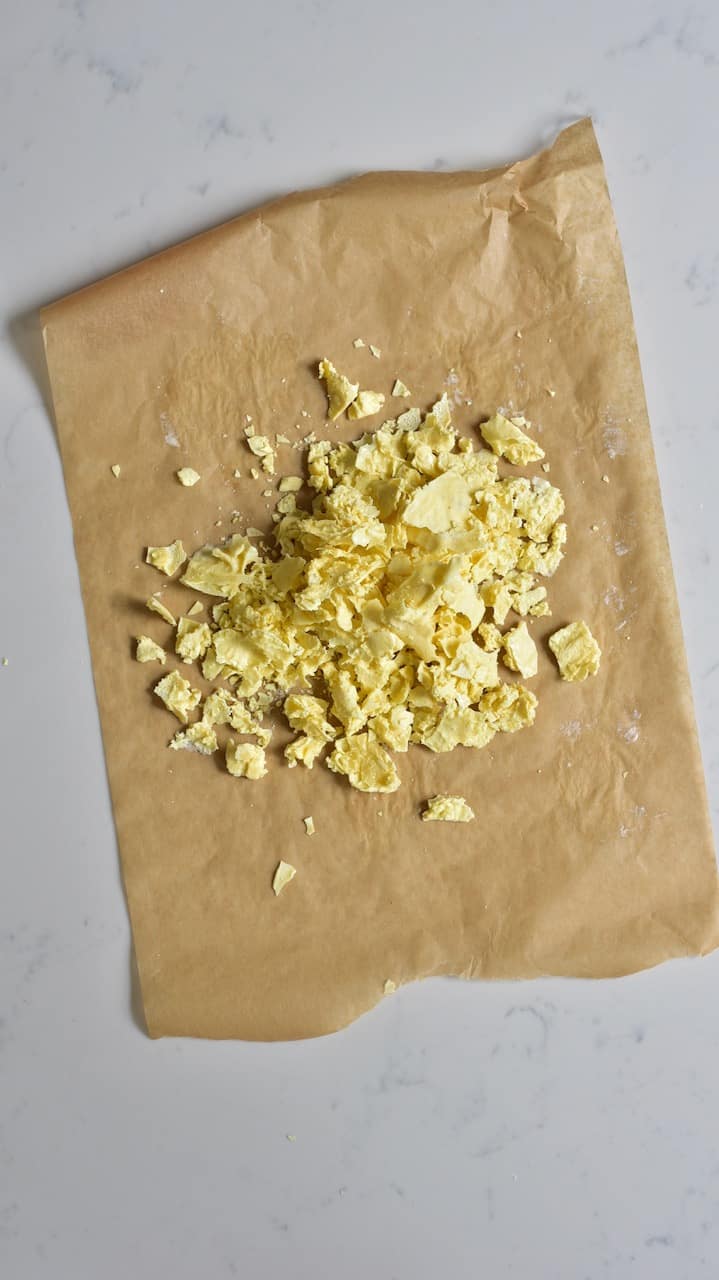
Grind the flakes into powder in a spice grinder or blender.
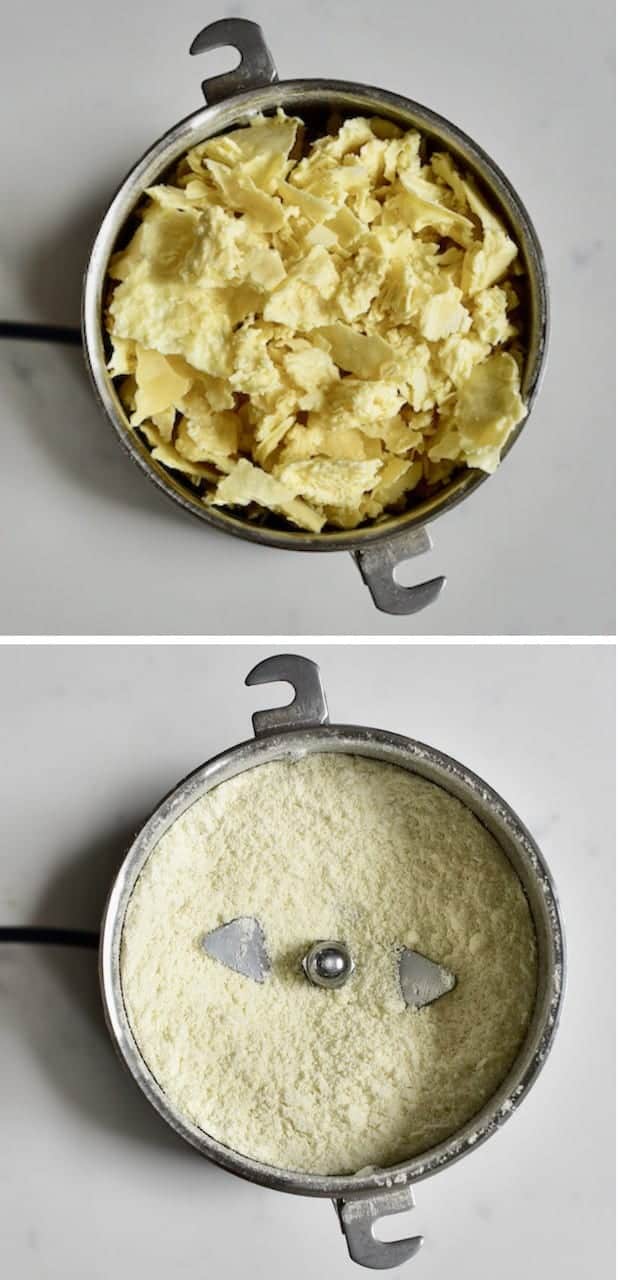
Pass the dehydrated milk powder through a fine-mesh sieve. Then grind the bigger pieces again- that way you’ll achieve a very fine powder.

Store the powdered milk in an airtight container. Make sure there is no moisture in it at all and keep stored in a cool, dark place. Milk powder can be kept for months, if not years this way.
If you have any questions, leave a comment below. Also, I love seeing your recreations so feel free to tag me on Instagram @AlphaFoodie.
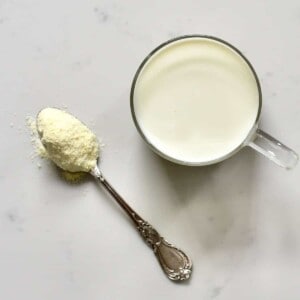
How To Make Powdered Milk At Home
Ingredients
- 1 L milk skimmed or full fat/whole milk will work
Instructions
- Pour room temperature milk into a big oven-safe dish. It's best to keep the milk at shallow levels, to dry out quickly. I tend to keep it at a maximum of an inch.
- Depending on the size of your oven and/or dish, you can pour the milk into several dishes. *
- Next, place the dishes into your oven at its lowest temperature. If it can go as low as 120-140ºF/50-60ºC, then that's ideal. Otherwise, select the lowest temperature that you can, using the fan-assisted option.
- If you don't have a fan option then leave the oven cracked open slightly, to let the evaporating liquid out so the milk dries quicker.
- As the water evaporates, the milk will become pastier and pastier until finally, it becomes a thick paste. Make sure the milk paste doesn’t turn brown while drying – that’s a sign that the temperature is too high.
- Stir from time to time – this allows the water to evaporate evenly, especially when the milk starts turning to a paste. **
- Once you get the milk paste, spread it out on a tray or over parchment paper and return to the oven or dehydrator to finish drying the milk.
- Once the paste is completely dry, you will be able to easily remove it from the tray/baking sheet. At this point, it will be easily snappable, with no bend.
- Grind the flakes into powder in a spice grinder or blender then pass the dehydrated milk powder through a fine-mesh sieve. Then grind the bigger pieces again- that way you’ll achieve a very fine powder.
- Store the powdered milk in an airtight container. Make sure there is no moisture in it at all and keep stored in a cool, dark place. Milk powder can be kept for months, if not years this way.
Video
Notes
Nutrition
Nutrition information is automatically calculated, so should only be used as an approximation.

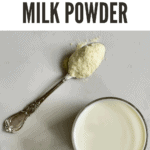
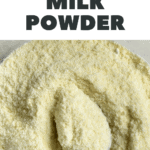
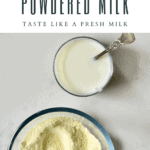
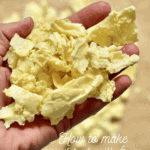
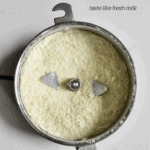
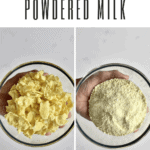

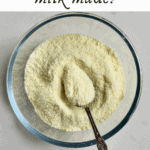
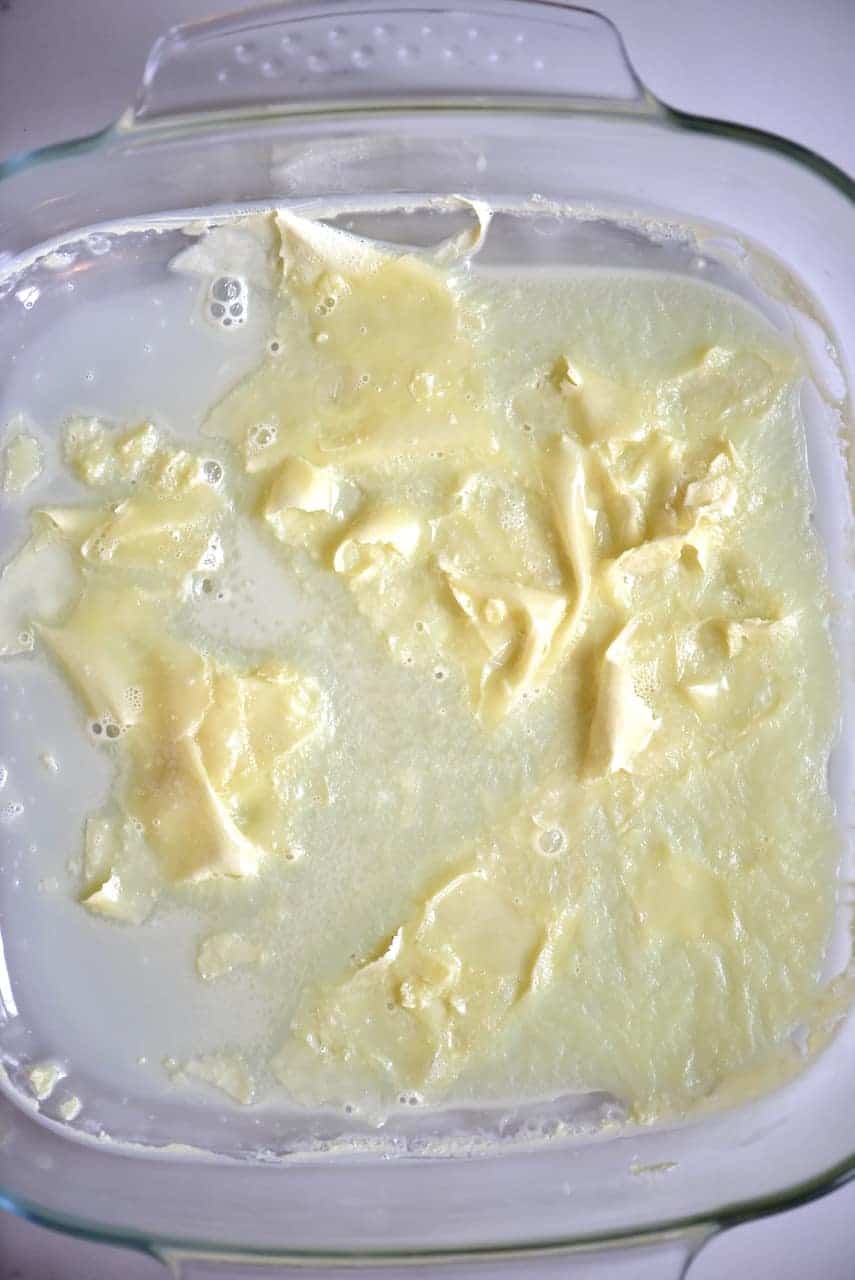
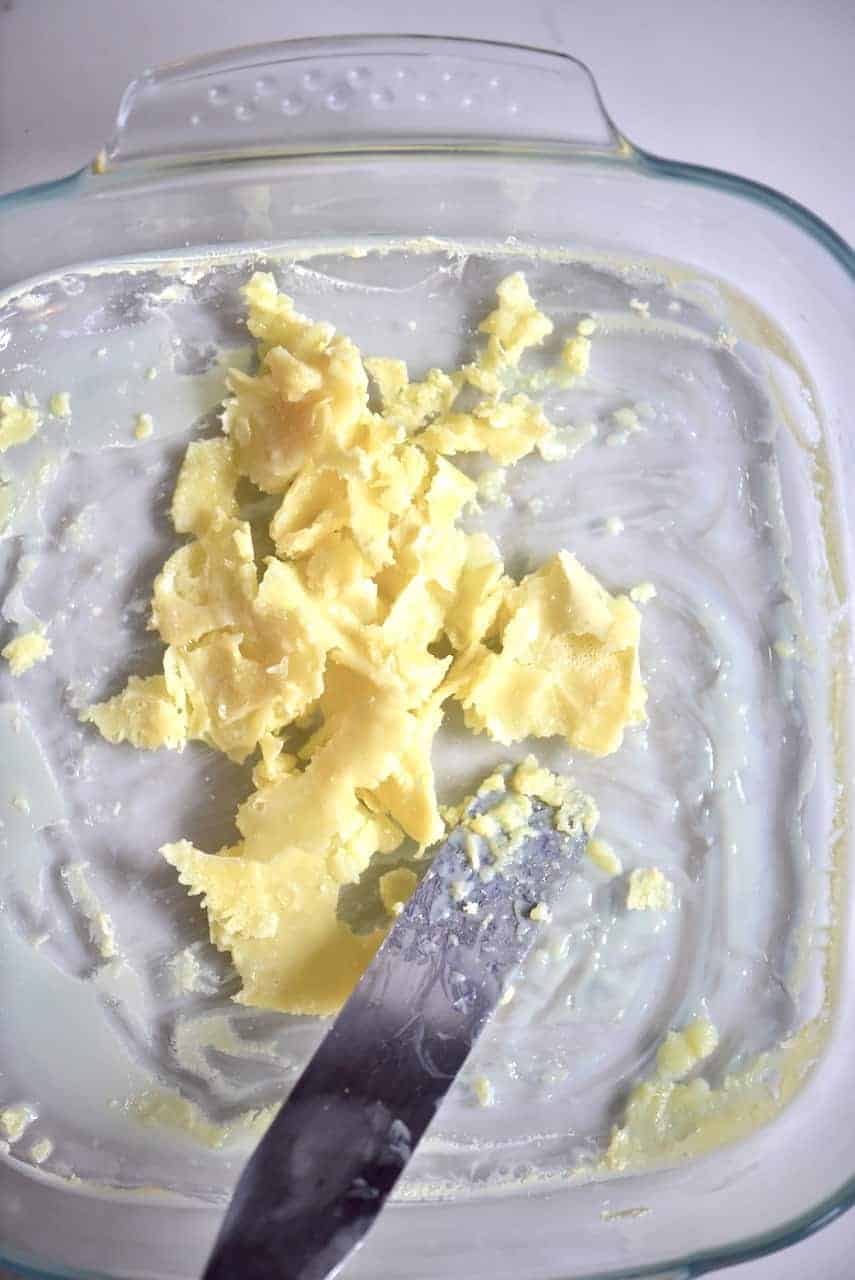
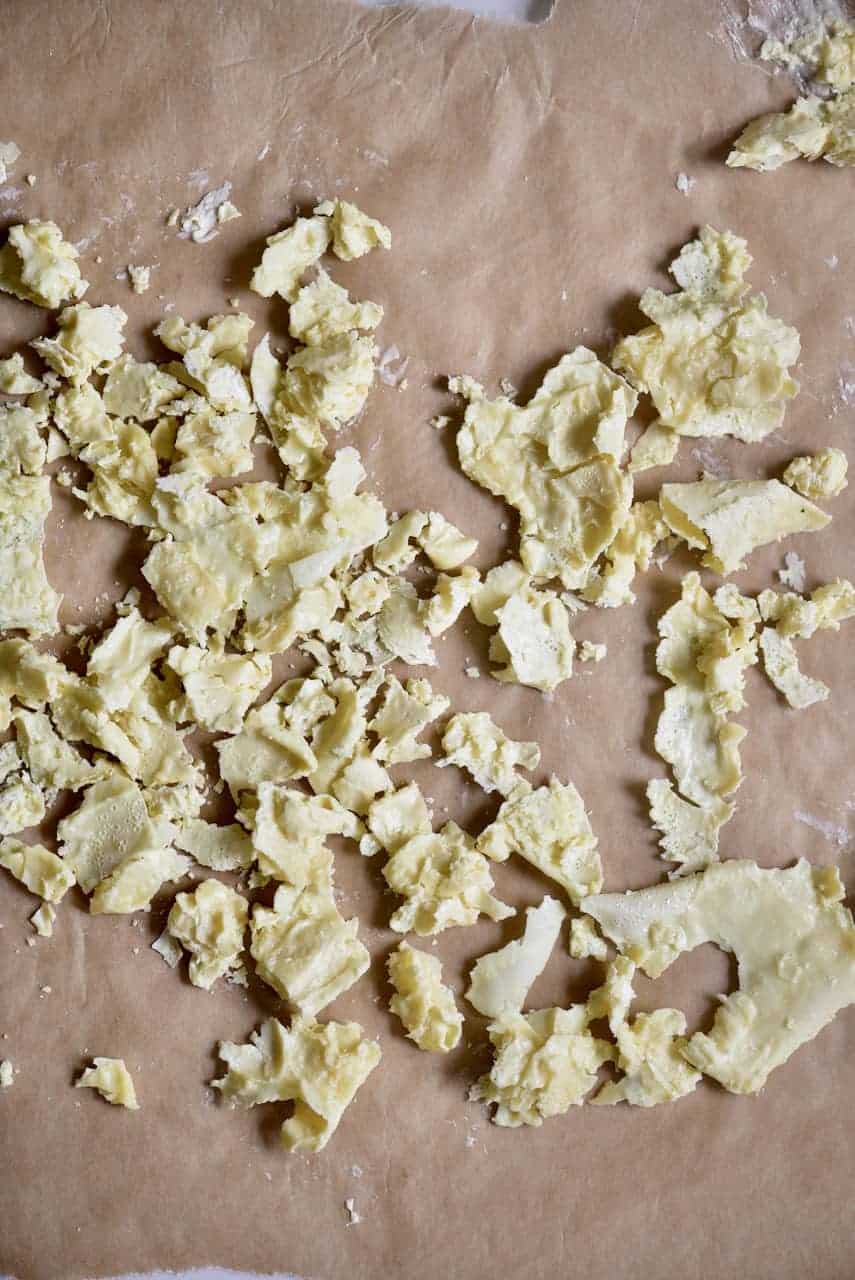
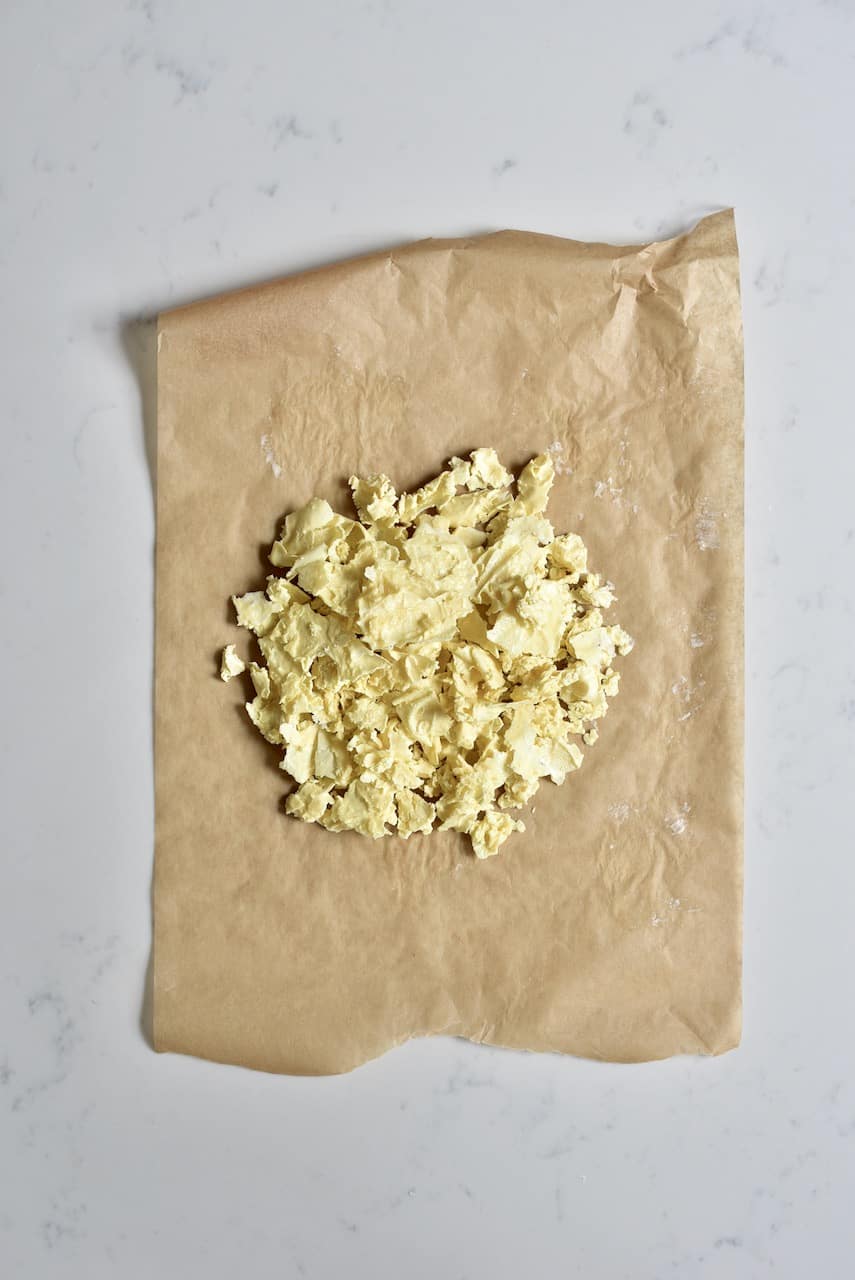









How do you reconstitute the homemade powdered milk? How do you make the powdered milk in bulk using a wood-fired oven? How do you make, store and reconstitute instant powdered milk in bulk?
Hi Chanel,
My preferred method to reconstitute powdered milk is to add 1 Tbsp of the powdered milk to 1 cup of water. If wanted, you can then easily increase the amount of powdered milk.
Can you regulate the temperature of your wood-fired oven? When dehydrating milk, the temperature needs to be low (at about 120-140ºF/50-60ºC). Higher temperatures will scorch the milk so I don’t recommend them.
Store the powdered milk in an airtight container. Keep it in a cool, dark place. Milk powder can be kept for months, or even years.
I hope this helps.
This looks super interesting! I’m wondering how many servings you get out of this amount. You begin with 1 liter if milk but how much powder is there with the finished product?
Hi Monique,
The yield for 1 liter was about 150 g. I hope this helps.
How long does the powdered milk last?
Hi Kristin,
When stored properly in an airtight container in a cool dark place, you can keep it for months, even years. Make sure there’s no moisture.
Hi. Can I use the same method to make Heavy Cream Powder? Thanks.
Hi Rebecca,
Yes, you can use the same method to make heavy cream powder.
Can I do lactose free milk?
Hi Tiffany,
Yes, you can use lactose-free milk for this.
Hi , does it have any kind of aftertaste or it taste exactly like ordinary milk
Hi Anwar,
It tastes just like ordinary milk when prepared correctly.
I acquire a large amount of fresh goat milk. Would I need to pasturize prior to dehydrating? Currently have two freezers almost full. I just want my freezer space back and make sure I don’t loose it if we loose power.
Hi Debbie,
I wouldn’t recommend using raw milk so it’d be best to pasteurize it first. Temperatures for proper pasteurization are higher than just for dehydrating the milk into powder. I hope this helps.
Is this a recipe for homemade instant powdered milk?
Hi Chanel,
Yes, it is.
Hello,
I have tried 4 times and prepared Milk powder on my stove at home. Aaparently I have good milk powder but problem comes when I transform milk powder into glass of water.
It does not steer well. Everytime milk powder sinks into glass and not dissolve into water properly.
Please advise.
Thank you.
Hi there,
Are you using lukewarm water or cold water? The powder can dissolve better in warmer water.
Also, I recommend grinding the milk powder very finely – this should allow it to better dissolve in the water.
We don’t have full-fat milk in the US, What milk can we (Americans) use?
Out of Curiosity, Can I dehydrate chocolate milk?
Hi Chanel,
You should be able to find whole milk or regular milk in the US. This is what I mean by “full-fat” – it has around 3.25% fat content.
I’ve never tried dehydrating chocolate milk. 🙂
Great, 5 star review from me.
Thank you so much, Finlay!
The best method to reconstitute milk that I am aware of is to mix it at about 4-6 times regular strength in a lidded container and shake vigorously for about 5 minutes. Then dilute it down to drinking strength with water. I still remember my dad making milk every evening in the 1960’s. 6 kids and not much money. He used to buy milk by the 50lb bag at the local dairy.
Thank you for sharing, David.
Hi David can you give an example please for say making a gallon of milk?
Thank you so much, I always end up throwing out milk, now I can extend the life of it
Glad to help, Kathi. Less food wastage is always a win 🙂